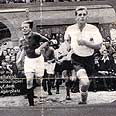
Czechs hail wartime Jewish league
Inside walls of transit camp of Terezin, Jewish footballers used their favorite sport as means of psychological escape from Nazi tyranny – if only for duration of match. League finally granted official recognition by Czech Football Association
"Playing football, we didn't think of deportation or the stress caused by life in the ghetto," famed Czech novelist and playwright Ivan Klima once said. Sent to the ghetto near Prague aged just 10, Klima played for the children's team "Blauweiss" (Blue-whites).
He was far from alone.
Inside the walls of the former Theresienstadt, a town-fortress founded in the eighteenth century by Austrian Emperor Joseph II, the Jewish footballers used their favorite sport as a means of psychological escape from Nazi tyranny - if only for the duration of a match.
Between 1941-1945, a total of 152,659 Jews passed through the giant Terezin complex, where the streets traced out a rectangular pattern between former army barracks and other military buildings, and moats cut it off from the rest of the world.
About 34,000 of them – men, women and children alike – perished from disease due to poor sanitation, while 87,000 others met their death after being deported to the Auschwitz-Birkenau Nazi German extermination camp in neighboring occupied Poland.
Just 16,852 of the Jews who passed through the Terezin camp, having been deported from their homes across Europe, survived the war.
Last month, the Czech Football Association executive committee declared "the football competitions and their organization in the Terezin ghetto during World War II an integral and important part of its history."

Photo courtesy of Beit Theresienstadt Archive
In 1943, a committee of Czech, Austrian, German, Danish, French and Italian Jews led by German Fredy Hirsch - who later perished in Auschwitz-Birkenau - created a system of football leagues including the "Terezin League," several divisions, as well as children's and junior leagues.
"Even in such cruel conditions the folks played football - and football helped them survive," says Stanislav Hrabe, head of a Czech Football Association (FACR) historical committee.
"Without any doubt, football is an unusual phenomenon that draws nations closer to each other. The leagues of the Terezin ghetto are an excellent example of this," he told AFP.
'A kind of comfort in hell's waiting room'
Named after the jobs the players had in the ghetto, such as "Cooks" ("Koeche" in German), "Used Clothes Storage" ("Kleiderkammer"), "Electricians" ("Elektriker"), and "Butchers" ("Fleischer"), the seven-a-side teams played games of two 35-minute halves in the courtyard of a former army barracks as thousands of fans watched.
In 1943, the "Used Clothes Storage" team came top of the first Terezin League, after six victories and three draws. The "Butchers" won the first Terezin Cup in the same year.
The ghetto prisoners also played international games such as Prague versus Vienna.
But player transfers scheduled every Monday from 10am to 2pm were a cruel reminder of the horrifying situation the footballers found themselves in: the lineups changed from week to week as players were deported to death camps.
Terezin players included ones with international careers, such as Paul Mahrer of the "Butchers" team, who as a DFC Prague star had played six games for the former Czechoslovakia in 1923-1926.
Mahrer survived Terezin and has since spoken of his experience, telling Frantisek Steiner, author of "Football Under A Yellow Star", "For us, football was a kind of comfort in hell's waiting room."










